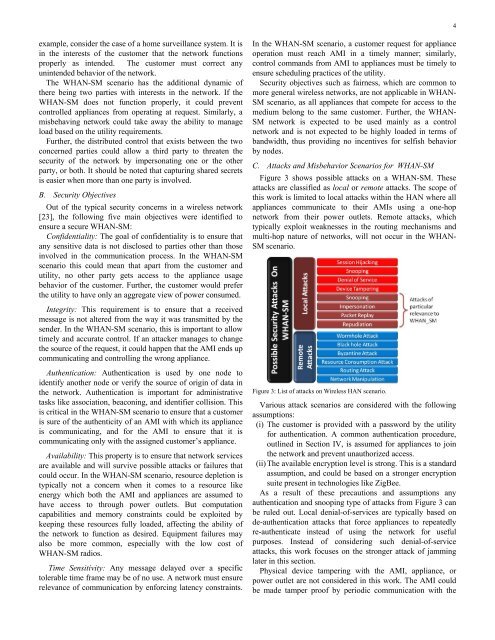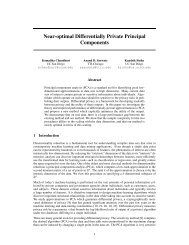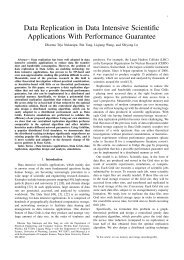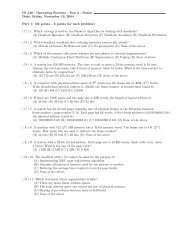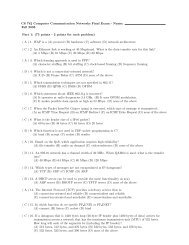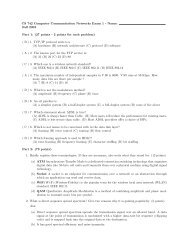Wireless AMI Application and Security for Controlled Home Area ...
Wireless AMI Application and Security for Controlled Home Area ...
Wireless AMI Application and Security for Controlled Home Area ...
You also want an ePaper? Increase the reach of your titles
YUMPU automatically turns print PDFs into web optimized ePapers that Google loves.
4example, consider the case of a home surveillance system. It isin the interests of the customer that the network functionsproperly as intended. The customer must correct anyunintended behavior of the network.The WHAN-SM scenario has the additional dynamic ofthere being two parties with interests in the network. If theWHAN-SM does not function properly, it could preventcontrolled appliances from operating at request. Similarly, amisbehaving network could take away the ability to manageload based on the utility requirements.Further, the distributed control that exists between the twoconcerned parties could allow a third party to threaten thesecurity of the network by impersonating one or the otherparty, or both. It should be noted that capturing shared secretsis easier when more than one party is involved.B. <strong>Security</strong> ObjectivesOut of the typical security concerns in a wireless network[23], the following five main objectives were identified toensure a secure WHAN-SM:Confidentiality: The goal of confidentiality is to ensure thatany sensitive data is not disclosed to parties other than thoseinvolved in the communication process. In the WHAN-SMscenario this could mean that apart from the customer <strong>and</strong>utility, no other party gets access to the appliance usagebehavior of the customer. Further, the customer would preferthe utility to have only an aggregate view of power consumed.Integrity: This requirement is to ensure that a receivedmessage is not altered from the way it was transmitted by thesender. In the WHAN-SM scenario, this is important to allowtimely <strong>and</strong> accurate control. If an attacker manages to changethe source of the request, it could happen that the <strong>AMI</strong> ends upcommunicating <strong>and</strong> controlling the wrong appliance.Authentication: Authentication is used by one node toidentify another node or verify the source of origin of data inthe network. Authentication is important <strong>for</strong> administrativetasks like association, beaconing, <strong>and</strong> identifier collision. Thisis critical in the WHAN-SM scenario to ensure that a customeris sure of the authenticity of an <strong>AMI</strong> with which its applianceis communicating, <strong>and</strong> <strong>for</strong> the <strong>AMI</strong> to ensure that it iscommunicating only with the assigned customer’s appliance.Availability: This property is to ensure that network servicesare available <strong>and</strong> will survive possible attacks or failures thatcould occur. In the WHAN-SM scenario, resource depletion istypically not a concern when it comes to a resource likeenergy which both the <strong>AMI</strong> <strong>and</strong> appliances are assumed tohave access to through power outlets. But computationcapabilities <strong>and</strong> memory constraints could be exploited bykeeping these resources fully loaded, affecting the ability ofthe network to function as desired. Equipment failures mayalso be more common, especially with the low cost ofWHAN-SM radios.Time Sensitivity: Any message delayed over a specifictolerable time frame may be of no use. A network must ensurerelevance of communication by en<strong>for</strong>cing latency constraints.In the WHAN-SM scenario, a customer request <strong>for</strong> applianceoperation must reach <strong>AMI</strong> in a timely manner; similarly,control comm<strong>and</strong>s from <strong>AMI</strong> to appliances must be timely toensure scheduling practices of the utility.<strong>Security</strong> objectives such as fairness, which are common tomore general wireless networks, are not applicable in WHAN-SM scenario, as all appliances that compete <strong>for</strong> access to themedium belong to the same customer. Further, the WHAN-SM network is expected to be used mainly as a controlnetwork <strong>and</strong> is not expected to be highly loaded in terms ofb<strong>and</strong>width, thus providing no incentives <strong>for</strong> selfish behaviorby nodes.C. Attacks <strong>and</strong> Misbehavior Scenarios <strong>for</strong> WHAN-SMFigure 3 shows possible attacks on a WHAN-SM. Theseattacks are classified as local or remote attacks. The scope ofthis work is limited to local attacks within the HAN where allappliances communicate to their <strong>AMI</strong>s using a one-hopnetwork from their power outlets. Remote attacks, whichtypically exploit weaknesses in the routing mechanisms <strong>and</strong>multi-hop nature of networks, will not occur in the WHAN-SM scenario.Figure 3: List of attacks on <strong>Wireless</strong> HAN scenario.Various attack scenarios are considered with the followingassumptions:(i) The customer is provided with a password by the utility<strong>for</strong> authentication. A common authentication procedure,outlined in Section IV, is assumed <strong>for</strong> appliances to jointhe network <strong>and</strong> prevent unauthorized access.(ii) The available encryption level is strong. This is a st<strong>and</strong>ardassumption, <strong>and</strong> could be based on a stronger encryptionsuite present in technologies like ZigBee.As a result of these precautions <strong>and</strong> assumptions anyauthentication <strong>and</strong> snooping type of attacks from Figure 3 canbe ruled out. Local denial-of-services are typically based onde-authentication attacks that <strong>for</strong>ce appliances to repeatedlyre-authenticate instead of using the network <strong>for</strong> usefulpurposes. Instead of considering such denial-of-serviceattacks, this work focuses on the stronger attack of jamminglater in this section.Physical device tampering with the <strong>AMI</strong>, appliance, orpower outlet are not considered in this work. The <strong>AMI</strong> couldbe made tamper proof by periodic communication with the


